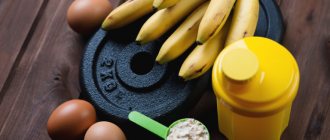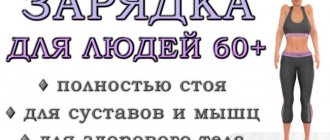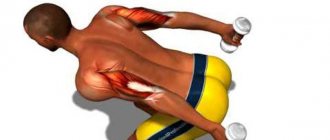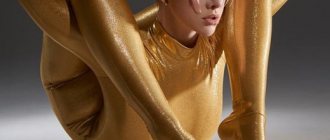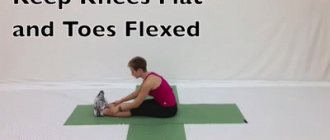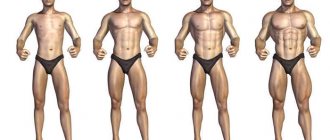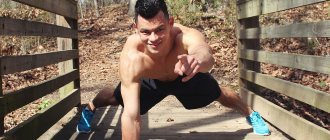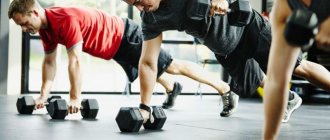Stiffness in the back and pain in the spine are common problems for people living in the era of technology. The occurrence of these conditions is facilitated by spending long periods of time doing sedentary work and using gadgets. Elderly people also suffer from pathologies of the spine; their movements are accompanied by pain and discomfort.
To support the functioning of the musculoskeletal system at any age, experts recommend performing a number of exercises for back flexibility. It is important not only to make your training effective, but also to make sure there are no contraindications. One of the advantages of performing the complex is the ability to support spinal health at home.
The relationship between back flexibility and health
The spine is the frame of the body; it is with its help that the main vital organs are correctly located and function. Back flexibility affects a person’s health in the following ways:
- Energy costs are reduced. When muscles in the human body contract, it is in a state of tension; when they are stretched, it is in a state of relaxation. Prolonged muscle contraction leads to significant energy consumption, as a result of which a person feels tired. Stretching the back muscles not only relieves tension, but also releases wasted energy.
- Improved blood circulation. Performing exercises improves blood supply to the spine and the muscles that support it, and supports the functioning of the heart and blood vessels.
- Improved coordination. Gymnastics to develop back flexibility helps the muscles not only relax, but also, on the contrary, stay in good shape. At the same time, coordination of movements improves, allowing you to quickly acquire new physical skills and abilities.
- Normalization of blood pressure. In parallel with the muscles, the blood vessels begin to function normally. Vascular walls relax at rest, which reduces blood pressure to normal. Especially useful for older people.
- Improving the functioning of internal organs. The functioning of the heart, respiratory and genitourinary systems is supported.
- Protection from injury. A flexible back allows you to maintain a high level of physical activity, perform complex exercises, and lift weights.
Note: Chinese doctors recommend restoring health, starting with developing back flexibility, improving the functioning of the spine and muscle frame.
Stretching is the key to beauty and youth of the body
Physical exercises to develop flexibility will help keep your body in good shape. Moreover, even professional athletes resort to them: swimmers, gymnasts, powerlifters. Many fitness programs are aimed specifically at developing mobility and elasticity of muscles and joints. This includes stretching, yoga, Pilates, and various dance routines.
But basic stretching exercises are also available for practicing at home, the main thing is to do them regularly, and then you can maintain a slim figure, correct posture and a beautiful gait for many years. In addition, a flexible body can withstand physical activity more easily and is less susceptible to injury (such as sprains).
Indications and contraindications
How do you know if your back is not as flexible as it should be? You should stand straight with your feet together. Try to touch your hands to the floor without bending your knees. If it doesn't work out, it's time to start training. It is recommended to improve the flexibility of the spine for people whose work involves long periods of driving, at the computer, or with a sedentary lifestyle.
Anatomical features of the spine
You also need to regularly stretch your muscles for joint diseases, osteochondrosis, and frequent back pain associated with weak muscles. Another indication is heavy physical work, during which the muscles of the lumbar region are regularly under tension. In addition to a healthy spine, exercise helps to tighten your figure and reduce body weight.
List of contraindications:
- traumatic injuries of the spine;
- osteoporosis;
- acute phase of joint inflammation;
- thrombosis;
- recent operations;
- tendency to hypertensive crises;
- oncological diseases;
- the first 3-4 days of the menstrual cycle;
- diseases of the heart and joints in the stage of decompensation;
- kidney and bladder diseases;
- ARVI, influenza in the acute phase with increased body temperature;
- period of bearing a child;
- severe pathologies of the respiratory system.
Why are such theories dangerous?
People begin to be afraid of their emotions, and instead of taking care of their health, they waste time on unproven methods of treatment. The person may also become afraid of their thoughts and feelings. Consider that he thinks or feels incorrectly, and that is why he is sick. Constant anxiety can trigger obsessive-compulsive disorder.
When a patient has cancer or another complex disease, it is easier to go to a psychologist or cry to friends than to admit that there is a problem in the body and decide on a complex course of treatment. This is a way to escape from reality and fear.
A person’s choice is often based on fear, and in this case, it may be the fear of admitting a problem to oneself, the fear of treatment, the fear of taking responsibility for one’s health. When a person turns to alternative medicine and believes in psychosomatic theories of the occurrence of diseases, he seems to remove responsibility for his life and transfers it to some kind of superpower, something abstract that cannot be influenced.
Whenever we experience certain bodily symptoms: disturbances in sleep, appetite, pain, “lump in the throat”, etc., we first need to properly treat the body. And only then look for zen.
Recommendations for implementation
The optimal time to perform the exercise is after a light dinner. This will relax your muscles and relieve fatigue before a night's rest. It is better to choose the same time every day. Before the complex, you need to warm up the muscles and ligaments; movements should be smooth, without jerking or sudden twisting. You need to give preference to clothes that will not hinder movement and retain heat inside the body during training.
For exercises performed in a horizontal position, it is better to take a special mat. You should not warm up on the carpet, since sudden movements can itch your skin. It is important to listen to your body. If pain appears in the back, lower back, joints and legs, stop the exercise or reduce the intensity of the exercise. For beginners, the number of repetitions of each exercise is up to 7, for regular exercisers – up to 15.
Note: The minimum number of classes per week is 4, the maximum is 6, that is, one day off must be required.
Not only does daily training make no sense in achieving your goals, on the contrary, you can also harm your body. To become truly flexible, you need to perform a full complex, devoting enough time to it. A reasonable lesson duration is from 30 to 50 minutes. More is possible, but not less.
Types of flexibility: characteristics and development exercises
The characteristics and types of flexibility are divided depending on the source of action and the method of manifestation.
The following classifications are used, according to form:
- active - the ability to perform amplitude movements using one’s own muscles;
- passive - the ability to perform amplitude movements due to external forces.
What types of flexibility exist depend on the purpose of the stretch. The most commonly used classification is based on the way flexibility is demonstrated:
- dynamic - flexibility in movement;
- static - in immobility;
- general - the ability to bend at any joints and amplitude;
- special - the necessary flexibility of certain joints and muscles for certain sports, for example.
Most often, combined stretching is used in training. And, if we are not talking about a sports competition, then general strengthening exercises are used to increase the range of motion.
Several factors influence flexibility:
- internal (anatomy);
- external (age, gender, warm-up, air temperature, etc.).
- The time of day (morning/afternoon/evening), for example, is also important. In the morning the body is quite “clogged” after sleep. And in the evening he disperses and is more obedient during training. The higher the air temperature, the better the body stretches. For example, in yoga there are special sections where people stretch in a room that resembles a sauna. This has a very strong effect on joints and ligaments, which become very obedient.
Having a warm-up (at least 15 minutes) is simply necessary for quality training for body flexibility. A warm body increases performance by up to 40%. Another factor that affects joint flexibility is the general condition of the body. If a person is tired, tired, then his active flexibility decreases, and his passive flexibility increases. While a positive attitude and general vigor improve the flexibility of the whole body.
Genetic structure
Many studies have shown a high influence of genotype on joint mobility and spinal flexibility. Of course, there are many factors: condition, elasticity, ligament properties and nervous regulation.
That is, the more flexible the ancestors in the family, the more likely their heirs are to “bend.”
Overall, girls are 25% more flexible than men. It is better to develop flexibility from childhood, because with age this ability decreases significantly. People of asthenic build bend worse than plumper people.
Speaking about joints, their structure is important: the most mobile ones are spherical. Ovoid and saddle-shaped have two axes of rotation, while cylindrical ones have only one. With flat joints, rotation as such is impossible, but only sliding of the two articular surfaces. Bone protrusions also contribute: if they get in the way of joint movement, they seriously limit their mobility.
Ligamentous apparatus
The quality of the ligaments is of great importance: thick ligaments and the joint capsule can significantly limit the mobility of different segments of the body. In addition, the range of movements can be limited by the action of antagonist muscles.
Thus, flexibility depends not so much on the elasticity of the ligaments, and not even on the characteristics of the joints, but also on the ability to combine tension with voluntary relaxation. Also, excessive use of strength exercises negatively affects the flexibility of the body.
Where to begin?
To develop back flexibility, you need to choose a special set of exercises. It is advisable that this be done by a specialist who will clarify the presence of problems with the musculoskeletal system, concomitant diseases, the level of muscle elasticity, joint performance, etc. Subsequent training can be done independently at home.
What to do before stretching:
- wear comfortable clothes;
- choose a suitable location;
- assess your health status, whether there is pain in any places, the presence of contraindications;
- do a light warm-up;
- work on your breathing technique.
If you lose your breath during exercise, do not sit or lie down. You should stop doing the exercise and walk slowly, you can drink a few sips of water. You should not expect quick results from training; the first achievements will be noticeable only after 2-3 weeks.
Development of flexibility
The main conditions for this: consistency and regularity of classes.
Sports that develop flexibility:
- Gymnastics (sports and artistic).
- Acrobatics (free and on canvases).
- Yoga.
- Stretching.
Each of the methods is good in its own way. Gymnastics focuses very heavily on flexibility as it is at the core of the discipline. Acrobatics evenly works both muscles and flexibility of the whole body. Yoga, on the other hand, focuses on balance throughout the entire body. Flexibility, endurance are developed, muscles are pumped, and all this is combined with breathing. Stretching is a popular area of physical education aimed specifically at stretching.
The types of flexibility in physical education are the same as in sports, but the focus is on complex exercises and stretching of the entire body: from the back, arms and legs.
The best exercises for beginners
Below we consider the recommended complex for those who are just starting training with the goal of developing spinal flexibility. Each exercise should be performed for 30-40 seconds.
| Name | Benefits of exercise | Execution Rules | Recommendations for simplification |
| Bend back while standing | Strengthening the back muscle corset, restoring the functioning of the thoracic spine, good posture | Stand up straight. Hands on waist. Bend back, bending in the lumbar region. Hips can be pushed forward slightly to maintain balance | Can be done while sitting, but do not tilt your head back too much |
| Sphinx pose | Developing lumbar flexibility, relieving muscle spasms, supporting lung function | Lying on your stomach, resting on the inner surface of your forearms. Palms parallel to each other, head looking straight | For pain in the lumbar region, fix the position for only a few seconds |
| Back arch | Stretching the back muscle corset, restoring the functioning of the thoracic region | Starting position, as in the sphinx pose. Next, you need to place your arms straight behind your back, extend them along your body and raise your body. Feet remain on the floor. | Performing a backbend in the sphinx pose, without putting your hands behind your back |
| "Swimmer" | Allows you to increase the flexibility of the spine, strengthen the legs, improve coordination of movements | Lying on your stomach, arms in front of you. The arm and the opposite leg are raised alternately, imitating the movements of a swimmer. Perform without sudden movements, smoothly | Reduce the range of motion or lift your legs first, then your arms, one at a time |
| Grasping the foot on all fours | Development of coordination and balance, spinal flexibility, calming effect | Position on all fours with one leg raised up without straightening the knee. The opposite hand clasps the foot of the raised leg, while arching the back. Repeat for the other side | You can use a fitness band or towel to grip your foot. |
| Half bridge | Strengthening the muscles of the back, lower back, pelvic floor, buttocks and thighs | While lying on your back, pull your feet towards your pelvis and bend your knees. Raise your pelvis, lifting it off the floor. Shoulders, head and feet remain on the floor. Hands parallel to the body. You need to lift your pelvis as high as possible, tensing your gluteal muscles at the top point. | The lumbar region can be supported with your hands, this reduces the load on it |
| Crunches | Development of mobility of the lower spinal column, muscle stretching | Lying on your back, pull one foot toward your pelvis, bending your knee. Move your hand to the side on the same side. When performing a twist in the lumbar region, move your knee in the opposite direction, trying to touch the floor with it. Hold for a few breaths, then repeat on the other side. | You can reduce the range of motion of your leg so that your knee does not touch the floor |
| "Arc" on the back | Relaxation of muscles in the thoracic and lumbar region, stretching of the spine | Lying on your back, place both hands behind your head, cross your legs at the feet. Turn the body and legs in one direction so that the body forms an arc | Arms can be extended along the body |
Who needs muscle strength training and when?
In addition to weightlifting athletes, powerlifters and athletes of various bench press competitions, strength training is relevant for bodybuilders who, with its help, overcome the “plateau” in achievements when the usual training and nutrition are no longer able to increase the volume and mass of muscles.
These exercises are also performed by some athletes in other sports, for example, as always, a brilliant example is American football players. Of course, although the training of football players consists of exercises aimed at increasing strength indicators, nevertheless, the training is aimed at the overall development of indicators.
List of exercises for advanced
Each exercise from this complex should be performed for 5-7 breathing cycles. The time is approximately 40-45 seconds.
| Name | Benefits of exercise | Execution Rules | Recommendations for simplification |
| "Cobra" | Development of lumbar flexibility, elimination of lower back pain, good posture | Lying on your stomach, stretch your legs, bring your feet together, place your palms on the floor. As you inhale, raise your body so that your pubic bone presses against the floor. And your palms should be pressed to the floor. Tighten your buttocks and thighs | For pain in the lumbar region, slightly raise the pelvis |
| Jefferson Crunch | Stretching the spinal column, relaxing the back muscles | Perform while standing on a cabinet or chair. Slowly lower your head, then twist your spine until you reach full range of motion. The wrists should be below the edge of the cabinet, do not bend the knees | The amplitude should be such that it does not cause pain in the back or lower back |
| Side plank crunches | Working out the muscles of the chest, arms, abdomen, endurance training | Position in a side plank with emphasis on the forearm, the second hand behind the head, the elbow looking up. Bend forward, touching your elbow to the floor. Rise, repeat | Reducing the number of twists |
| "Fish" | Relaxes the pelvic floor muscles, strengthens the hips | Lie on your back, bend your knees and place your shins on the sides of your body. Raise your body, keeping your head and pelvis on the floor | Performed with straight legs or in half lotus position |
| Hyperextension | Development of the erector spinae and gluteal muscles | You need a hyperextension machine or any bench that you can grab onto with your feet. Place your hands behind your head and lower your body until it is parallel to the floor. Next, pull your body up, moving your shoulders back and straightening your back. | Arms can be crossed over the chest or placed on the sides of the body |
| Bridge | Improving posture, developing flexibility of the spinal column, getting rid of back pain | Lying on your back with your palms placed under your shoulders. Climb to the bridge | Perform a half bridge |
| Bridge with alternating leg raises | Improving posture, developing flexibility of the spinal column, getting rid of back pain | The first part of the exercise is performed as a “bridge”. Next, you should alternately raise your legs | Perform a half bridge without raising your legs |
Special mention should be made about the “child’s pose.” It must be performed between other exercises, every 5-7 minutes during training. The exercise does not make the back more flexible, but it allows you to relax the muscles after heavy poses, twisting, and bending. To perform this, you need to get down on all fours and stretch your arms forward. Lower your pelvis onto your heels, face down, head touching the floor.
If you experience pain, you can simplify the pose: do not stretch your arms forward, but bring them to the sides of the body. You can turn your head a little in one direction or another. This will allow you to relax your cervical spine and surrounding muscles as much as possible.
Content
- 1 Flexibility exercises 1.1 Standing quadriceps stretch
- 1.2 Warm up the ankles
- 1.3 Pulling the knee to the chest while standing
- 1.4 Calf stretch
- 1.5 Achilles tendon stretch
- 1.6 Side lunge
- 1.7 Straight leg stretch
- 1.8 Quadriceps stretch while kneeling
- 1.9 Pretzel
- 1.10 Groin stretch I
- 1.11 Groin stretch II
- 1.12 Lower back stretch I
- 1.13 Lumbar Stretch II
- 1.14 Three-position stretch
- 1.15 Tilt to straight leg
- 1.16 Stretching with body rotation
- 1.17 Pulling the knee to the chest using a uniform
- 1.18 Transverse stretch
- 1.19 Straight leg pull-up
- 1.20 Barrier
- 1.21 Lying quadriceps stretch
- 1.22 Transverse arm stretch
- 1.23 Hand behind head
- 1.24 Stretching the finger flexors and extensors
- 1.25 Side tilt
- 1.26 Abdominal stretch
- 1.27 Comprehensive neck stretch
Tips for Improving Training Results
Stretching for the back and spine
Tip #1
Assess the adequacy of physical activity in daily life. Constantly sitting or, conversely, regularly lifting heavy loads has a negative impact on the condition of the musculoskeletal system. Alternate activity modes with proper rest.
Tip #2
Evaluate your sleeping space. Very old, sagging sofas are not the best option for a night's rest. The muscles become stiff, the back hurts in the morning, the person is constantly tired and lacks sleep. Choose a mattress that is optimal in terms of firmness.
Tip #3
Include in your menu foods rich in protein (eggs and dairy products, meat and fish, legumes) and calcium (cottage cheese, cottage cheese, cabbage and liver). Don’t forget about vitamins, which are found in sufficient quantities in fresh vegetables and fruits and herbs.
Tip #4
Give up bad habits: drinking large amounts of coffee, alcoholic beverages, smoking.
What is the difference between psychosomatics and somatoform disorders
Source here and below: Pexels
There is evidence-based medicine, and there is alternative medicine, there are proven drugs, and there is homeopathy. There is also psychology and psychiatry, which examine the interaction of the mind and body from different angles, and there is so-called psychosomatics, which has no scientific evidence or evidence base. All these hypotheses, for example, that a sore throat appears from unspoken images, are just theories, and they have nothing to do with science or medicine.
In medicine and psychology, they actually study disorders of physical functions that are psychogenic in nature, that is, caused by emotions and experiences. But this is not exactly the “psychosomatics” that books are written about and which is popular on the Internet.
Herodotus began to describe the influence of emotions on the body; Freud and other psychoanalysts studied this more thoroughly. They were studying how emotional problems can affect a person's health: for example, if you have allergies, maybe you didn't have enough motherly love. Now we already know that these are unrelated things.
There are three types of somatoform disorders.
Functional disorders
These are disorders that mainly arise due to stress or overexertion. This could be pain in the heart or stomach, headache. At the same time, the organs are healthy and there are no somatic disorders.
Conversion disorders
These are mental disorders in the structure of which various bodily sensations play the greatest role. This can cause convulsions, a person loses vision, and disturbances in motor activity begin. For example, a person is previously diagnosed with epilepsy, but when checking brain activity, it turns out that everything is fine. The patient unconsciously begins to imitate such attacks through emotional experiences and this happens not from the body, but from the psyche. Another person may think he doesn't see and actually feel it. At the same time, the organs and brain will reflect information.
Bodily symptoms associated with hypochondriacal disorder
This includes a variety of internal and external sensations of a person in the organs. A person convinces himself that he has a disease and begins to experience symptoms characteristic of this disease.
For the brain there is no difference between real and unreal: if you tell yourself that you have pain here, the brain sends nerve impulses and checks. And we react to these signals as if it were pain.
Warm up before stretching
When you stretch after a workout, your muscles are already warmed up and no additional warm-up is required. If you decide to arrange a separate stretching lesson, first do a few exercises:
- Joint warm-up: twirl your joints, bend and twist your body.
- 5-7 minutes of cardio: running or Jumping Jacks, Rock Climber, running in place with high knees, jumping rope.
Once you've warmed up a bit, you can start stretching.
Chest stretching exercises
Chest stretch in the doorway
Approach the doorway, lean your elbows on the doorframes and push your chest forward, stretching your pectoral muscles.
Wall Chest Stretch
Place your hand on the wall, lower your shoulder and turn in the opposite direction. Repeat with the other hand.
Calf Stretching Exercises
Stretch against the wall
Press the toe of your right foot against the wall, take your left foot a step and a half back. The feet are pressed tightly to the floor, the left leg is straight. Try to reach the wall with your right knee, this will stretch the muscles of your left leg.
Switch legs.
Heel Wall Stretch
Stand close to the wall. Place your right toe on the wall, take your left leg a step and a half back. Bend your left leg at the knee, increasing the stretch. Switch legs and repeat.


